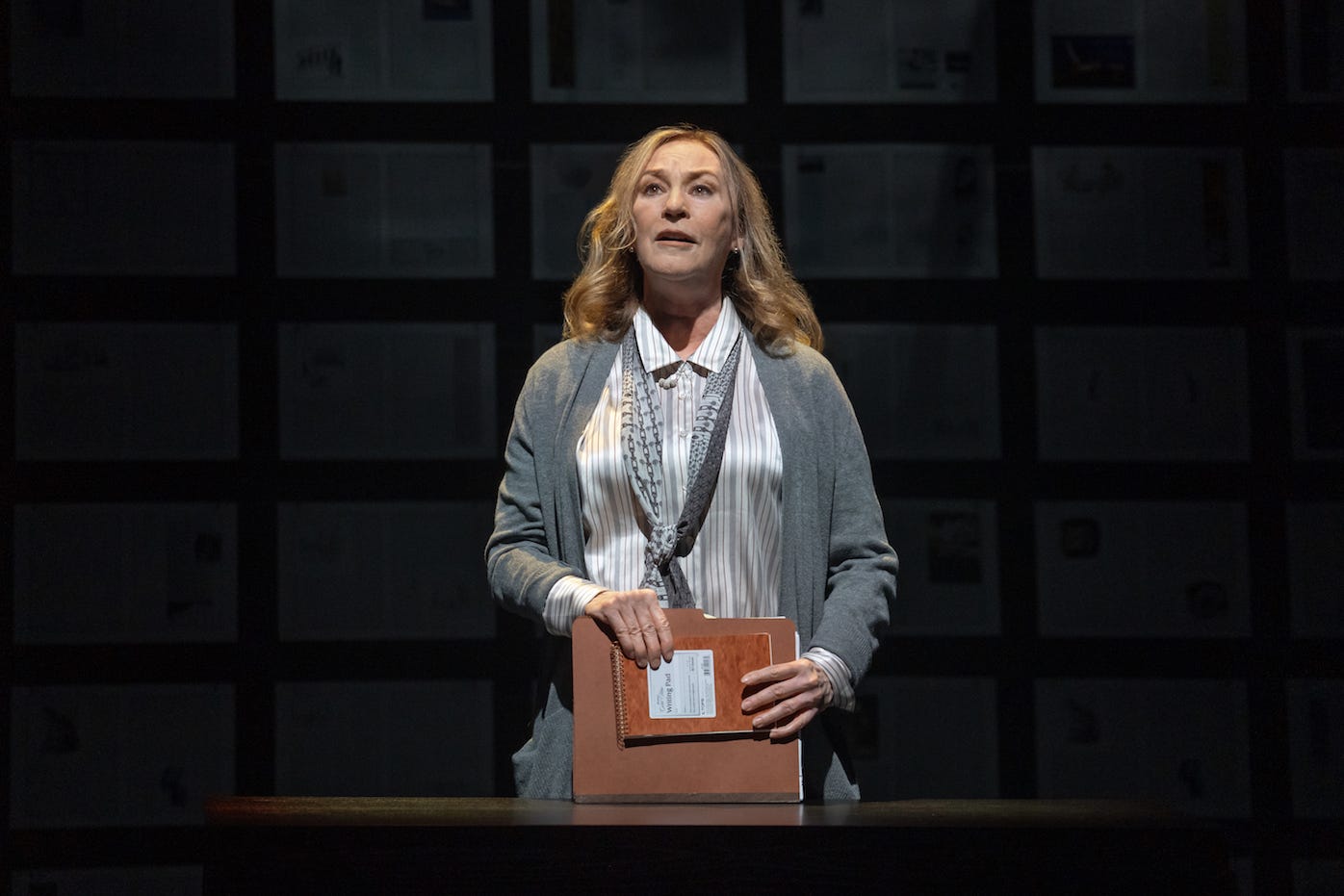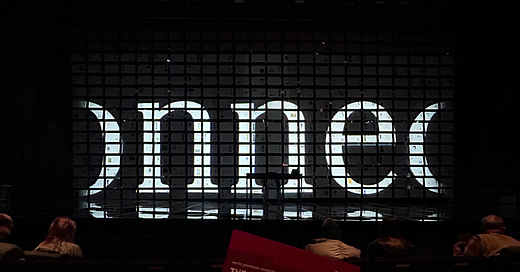"The Connector," or, Questioning Fact, Truth, and My Ability to Write an Article on Time
They didn't have Substack then, but they did have really fun outfits.
Unlike Ethan Dobson, the protagonist (or villain?) of Jason Robert Brown’s new musical “The Connector,” I am having trouble writing.
I’ve had various drafts of my newsletter about “The Connector” staring at me every time I’ve opened my laptop for the last three weeks, but I can’t seem to find the right lede, the right summary, the right note to hit. I guess all of this is to say that “The Connector” is a musical that has stayed with me — partly because I really enjoyed it, partly because it left me with a lot of questions about journalism, truth, and the role musicals should (or shouldn’t) play in trying to make a statement about the present.
Let’s start with the enjoyment. “The Connector” is a special musical in the way all of its elements align to capture a specific time, place, and culture: 1990s journalism. The show follows a magazine of the musical’s name in 1996 to 1997.
Every aspect of the show works impeccably well to bring us back into this time and into the magazine’s office. The music somehow sounds like it’s from every 90s video, TV show, or movie I’ve watched. The costumes are picture perfect: dress shirts in different shades of grays, skirt suits, thin, sleek watches. The set is a minimalist grid that transforms into different offices, a bar, and even backdrops for different articles that appear in the magazine. On the sides of the very-wide stage, there are piles and piles of newspapers, which the company sits on for most of the show.
I went to this show because of the composer, Jason Robert Brown, who wrote one of my favorite shows of last year (the revival of “Parade”), “The Last Five Years,” which led me to sing “Summer in Ohio” on repeat for the entire summer of my sophomore year, and “13,” one of the first musicals I knew the soundtrack to by heart. The music did not disappoint. It does more than capture the sound of 1990s journalism; it gives voice and detail to the people and their stories that make the magazine what it is. It helps that it’s very beautifully sung, especially by Ben Levi Ross, who plays the show’s aforementioned protagonist (and potential villain), who is in his peak Evan Hansen-tenor form.
One of my favorite parts of the show is how it unravels through each song. Within the first five minutes of “The Connector,” we learn that the magazine shuts down in late 1997. We’re placed just a year before then, where we meet all-too-eager Ethan Dobson, who’s waddled his way over from Princeton, expecting to land his first big story just as he’s gotten his diploma. He essentially does just that. Editor-in-chief Conrad O’Brien (Scott Bakula) immediately hires him, much to assistant copy editor Robin Martinez’s (Hannah Cruz) distaste. She, on the other hand, has been trying to get Conrad to publish her work for over a year.
From there, the show follows a neat sequencing, tracing Ethan’s stories throughout the year. The first is part of an incredible number about a Scrabble champion, Waldo (Max Crumm). The show’s backdrop, a giant wall filled with articles, transforms to become a Scrabble board with connecting words on it. The second article is more scandalous; it’s a damning report of the Jersey City mayor, and we hear from Ethan’s source, Willis (Fergie Philippe, but I saw the wonderful understudy Cedric Lamar) in a beautifully written, impressive feat of a powerful ballad.
Ethan’s articles are quickly a hit — and quite literally, the songs are, too. I love that we get to hear a reader’s view of Ethan’s success; there’s a recurring epistolary character, Mona Bland, who only appears to read her letters to the editor that praise Ethan.
We also get the opposition to Ethan’s articles in two different camps. The first is Robin, who picks on his privilege, telling Ethan he was “born on third base but thinks he’s hit a home run.” She’s been trying to get stories in “The Connector” for years, but Conrad continually ignores her. The culprit? Sexism. While some of her prodding is obvious, it feels essential — and when Ethan picks on her for trying to get published in another paper, the lines truly sting.
The second camp comes mostly from the fact checker Muriel (Jessica Molaskey), who brings up that she can’t verify Ethan’s story about the mayor. This is where I believe this musical’s writers hope the crux of the show lies: what is fact, and what is fiction? What is fact, and what is truth? How can we prove something should be believed? While Conrad says he believes Ethan, and therefore Muriel should, too, she’s firm in her resolve against him and devotion to the facts. Muriel’s song about “proof” is tear-jerking. I liked that they used a fact checker, a position often overlooked, to voice the musical’s main concerns, making them personal to her life and career story.

Truth and fact continue to blur as Ethan works on his next story. We know where all of this is going — we know “The Connector” is going to shut down, and soon — but it’s like a car crash you can’t look away from. Ethan is spiraling to a doom but the journey is so engaging, so heartbreakingly sung and acted that I can’t tell who we’re supposed to be rooting for, and who we really want to believe.
This is where my conflict about “The Connector” begins.
The show’s marketing and reviews talk about “The Connector” and “fake news.” It does investigate themes like truth, privilege, and who gets to tell stories, but I’d argue its strength is really being a show about 1990s journalism. We truly feel like we’re in “The Connector” office, from the pages on the side of the set to the stereotypical journalist outfits. In one of the final songs, the whole cast shreds paper to the beat. I’d almost wished there was even more of the paper, the writing, the typing to emphasize what the show is about: a newsroom, where people are trying to write the next best story.
Yet it’s also a show that’s frozen in time. Even as it sings vague, universal truths about truth, it’s more of a black and white story about the accuracy of print journalism versus getting close to the problems we face with the media today.
In the last few weeks, that’s what I’ve struggled with; would “The Connector” feel more powerful if it investigated the gray areas in journalism we see today? What are the repercussions of bending the truth? Of leaving certain facts out? Of ordering events in a specific way, of the angles a journalist can take? Of using certain adjectives to describe certain groups of people, or using passive voice to make someone or some entity sound less culpable than they are?
Perhaps these are questions that are too much for a musical to answer. Perhaps they’re not ones “The Connector” should expect to touch. Yet in a time when journalism seems to be dying, when “fake news” can affect election outcomes, or skewing coverage can have real, deadly outcomes, it’s what I’m going to be thinking about when I’m watching a very beautiful original show about a fake famous magazine.
Thanks for reading! “The Connector” closed this past weekend, and I hope it has a life beyond MCC Theater. Here’s the gist:
How I found out about it: A mix of different marketing strategies, honestly. Emily and I attended a really incredible talk called “The Pressure on the Press” at MCC earlier this year, and they mentioned the show then (and gave us a $10 discount, but only for a limited number of performances). I also follow MCC on Instagram and saw a lot of their promos there.
Why I went: Jason Robert Brown and new musicals! The opportunity to see new work from someone so talented was really exciting and definitely worth it.
How I got tickets: Rush!! Emily very kindly walked to the theater from her theater and seamlessly got us $35 tickets around 5 p.m. the day of the show. Bonus points: Paul Rudd was in the audience the night we went.





